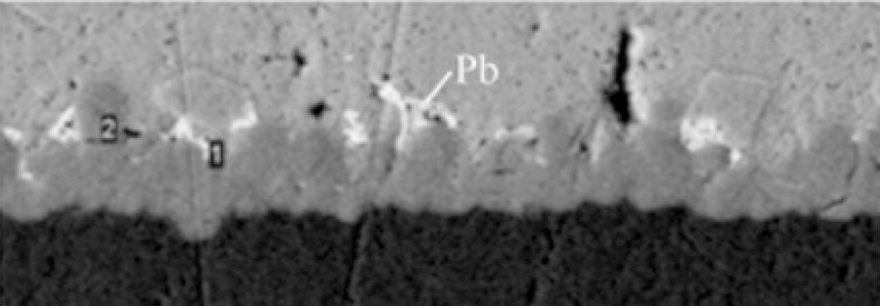The Effect of Metal Segregation on the Reliability of Welded Joints_Shenzhen Fitech

The Effect of Metal Segregation on the Reliability of Welded Joints
Metal segregation is a common phenomenon in the welding process, which refers to the inhomogeneous chemical composition distribution in the metal alloy.
Some scholars have studied the influence of interface microstructure in crack growth, pointed out that the growth rate of fatigue cracks along the solder interface is related to the stress released with the aging time. In a long period of high-temperature aging, such as aging at 140 ° C 7 ~ 30 days, due to the Sn in the solder near the interface with the base metal Cu metallurgical reaction to form CuSn intermetallic compounds in the process of consuming Sn, and thus in the immediate vicinity of the interface of the IMC to form a continuous Pb-rich phase region and cause Pb segregation, as shown in Figure.

Figure 1. Pb segregation
Sequestration affects the reliability and performance of solder joints in the following ways.
Metal segregation results in inhomogeneity of chemical composition in the welded joint, which leads to localised differences in mechanical properties. Some areas may become brittle and prone to cracking or fracturing due to higher levels of the deviated elements. This can significantly reduce the strength and toughness of the welded joint, which in turn affects the overall stability of the welded structure.
Increased risk of corrosion
Metal segregation results in certain areas of the welded joint containing more corrosion-sensitive elements, making these areas corrosion-prone in the welded structure. Over time, these areas can be damaged by corrosion, ultimately leading to welded joint failure.
Reduced Fatigue Life
Metal segregation causes localised differences in properties in welded joints, which can lead to stress concentrations under cyclic loading. When the welded structure is subjected to frequent loading, these highly stressed areas are prone to fatigue cracking and gradual expansion, ultimately leading to welded joint failure. Therefore, metal segregation reduces the fatigue life of welded joints and limits the service life of welded structures.
Impact on electrical and thermal conductivity of welded joints
Metal segregation leads to an uneven distribution of electrical and thermal conductivity in the welded joint, which affects the electrical and thermal properties of the welded structure. This is particularly important in applications such as electronic package soldering, where the conductivity and thermal performance of the solder joint is directly related to the stability and performance of the device.
In order to cope with the impact of metal segregation on the reliability of solder joints, the following measures can be taken:
1. Select metal alloys with better anti-segregation properties such as nickel-based alloys to reduce the possibility of metal segregation.
2. Optimise the welding process: Reasonably adjust the welding parameters and process to ensure the uniform distribution of the metal composition in the welding process.
3. Heat treatment and annealing: appropriate heat treatment and annealing process can eliminate or reduce the metal segregation phenomenon, improve the mechanical properties of the welded joint.
4. Quality inspection: through comprehensive welding quality inspection, early detection of segregation problems and take corresponding measures to ensure the reliability of the welded joint.

















 Back to list
Back to list



